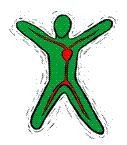Cellular Biology
In this lesson, we learn what cells are, their major components, and the functions of these organelles.
Objectives:
• Understand what a cell is and how it relates to higher biological structures
• Learn what the major organelles in a cell are and their functions
• Identify differences between eukaryotic and prokaryotic cells
Suggested Grades:
6th Grade - 7th Grade - Eighth Grade
Print the reading comprehension passage and questions (see below).
Students should read the passage silently, then answer the questions. Teachers may also use the text as part of a classroom lesson plan.
Lesson Excerpt:
What is a cell?
Over billions of years, the biological universe has developed a diverse variety of organisms from trees to bacteria to humans. All organisms are composed of basic units called cells, which consist of numerous chemicals and molecules. Following is the hierarchy of how various organs, tissues and cells relate to each other:
Organisms > Organs > Tissues > Cells
The cells are virtually the smallest living units. While all living things contain the so-called cells, there are differences between cells of different organisms. For instance, animal cells have a different structure than those of plants. This is why there is a branch of science called the cell biology, to understand how they function.
Continued...

Lesson Printables:
Print this printable worksheet for this lesson:


